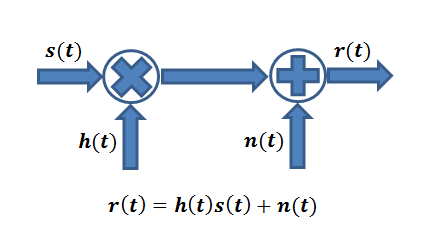I - In the previous two posts we discussed MSK performance in an AWGN channel, first presenting the MATLAB/OCTAVE Code for one sample per symbol case [Post 1], and then extending it to the more general case of multiple samples per symbol [Post 2]. This helps us visualize the underlying beauty of Continuous Phase Modulation (CPM) which reduces out of band energy and consequently lowers Adjacent Channel Interference (ACI). We also briefly touched upon the case of MSK in Rayleigh fading, but did not go into the details. So here we take a deeper dive.Continue reading MSK Bit Error Rate in Rayleigh Fading
Category Archives: Simulation
MSK – A Continuous Phase Modulation (CPM)
Some Background on MSK
I – In the previous post we presented the mathematical model and code for BER calculation of a popular modulation scheme called MSK. However in the code we shared, we only considered one sample per symbol, which makes MSK look like BPSK. While BPSK symbols fall on the real axis, MSK symbols alternate between real and imaginary axes, progressing by π/2 phase during each symbol period. MSK signal thus has memory and this can help in demodulation using advanced techniques such as Viterbi Algorithm.Continue reading MSK – A Continuous Phase Modulation (CPM)
Minimum Shift Keying Bit Error Rate in AWGN
I - Minimum Shift Keying (MSK) is a type of Continuous Phase Modulation (CPM) that has been used in many wireless communication systems. To be more precise it is Continuous Phase Frequency Shift Keying (CPFSK) with two frequencies f1 and f2. The frequency separation between the two tones is the minimum allowable while maintaining orthogonality and is equal to half the bit rate (or symbol rate, as both are the same). The frequency deviation is then given as Δf=Rb/4. The two tones have frequencies of fc±Δf where fc is the carrier frequency. MSK is sometimes also visualized as Offset QPSK (OQPSK) but we will not go into its details here.Continue reading Minimum Shift Keying Bit Error Rate in AWGN
Pulse Amplitude Modulation Symbol Error Rate in AWGN
Pulse Amplitude Modulation (PAM) is a one dimensional or in other words real modulation. Simply put it is an extension of BPSK with M amplitude levels instead of two. This can be a bit confusing because BPSK can be looked at as a phase modulation and its natural extension must be QPSK or 8-PSK modulations. To remove this ambiguity lets call M-PAM an extension of simple amplitude modulation but with M levels. In the discussion below we consider M=4 but then extend it to the general case of M=2k (k=1,2,3…).
Continue reading Pulse Amplitude Modulation Symbol Error Rate in AWGNWireless Channel Modeling: Back to Fundamentals

When a wireless signal travels from a transmitter (Tx) to a receiver (Rx) it undergoes some changes. In simple terms the signal s(t) is scaled by a factor h(t) and noise n(t) is added at the receiver. Let’s take this discussion forward with a simple example. Suppose the Tx transmits one of two possible symbols, +1 or -1. In technical lingo this is called Binary Phase Shift Keying (BPSK). If the channel scaling factor is 0.1 we will either get a +0.1 or -0.1 at the Rx to which AWGN noise is added. The noise is random in nature (having a Gaussian distribution) but for simplicity we assume that it can have one of two values, +0.01 or -0.01.
Continue reading Wireless Channel Modeling: Back to FundamentalsMassive MIMO and Antenna Correlation
Some Background
In a previous post we calculated the Bit Error Rate (BER) of a Massive MIMO system using two different channel models namely deterministic and probabilistic. The deterministic channel model is derived from the geometry of the array (ULA in this case) and the distribution of users in the cell. Whereas probabilistic channel model assumes that the channel is flat fading and can be modeled, between each transmit receive pair, as a complex, circularly symmetric, Gaussian random variable with mean of zero and variance of 0.5 per dimension.
Continue reading Massive MIMO and Antenna Correlation